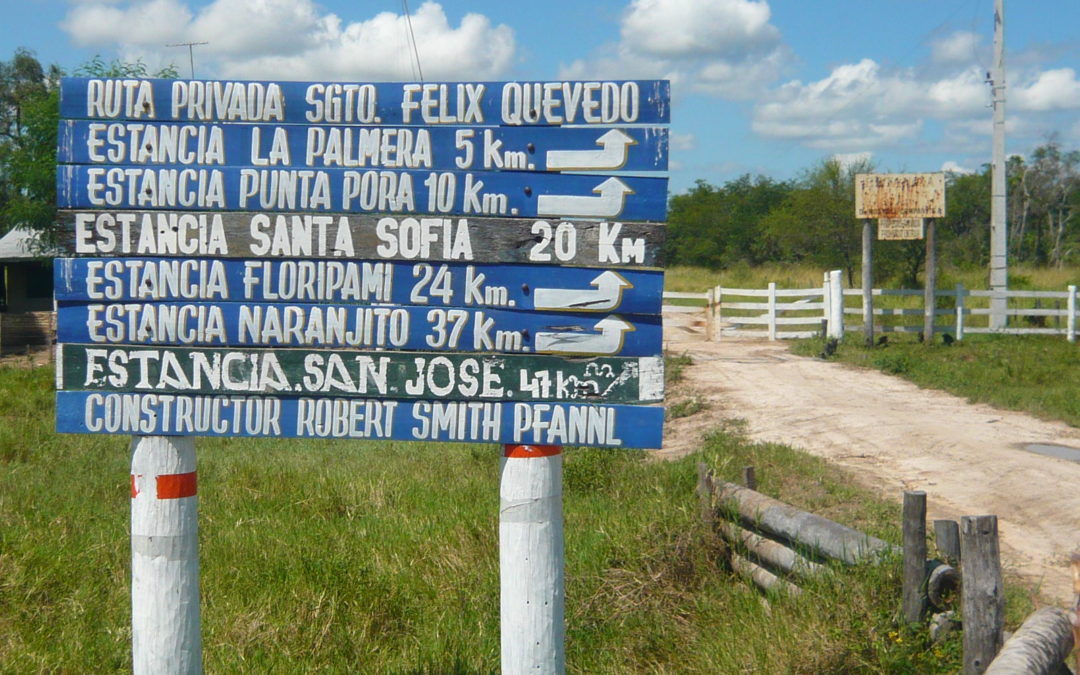Travelling across Paraguay and it does not take long before you leave the tarmac behind. The lines of tarmac tend to be the strings joining one town to the next. The web of roads linking all places in between is surfaced with dirt or occasionally cobbles.
My home is set 5km back from the road linking the towns of Piribebuy and Paraguari. In Paraguayan terms that is considered just a short distance from the tarmac. Many homes are buried far deeper into the countryside down much rougher roads.
My road is by the standards of Paraguayan roads quite wide and well maintained. This is due to it being one of the more important minor roads. Rather than simply ending amongst a group of homesteads it runs the full length of a valley reaching tarmac at either end. In doing so it serves a number of settlements along its course.
I usually join the track at the end nearest Piribebuy. The Paraguari end of the track is double the distance from the house. Pulling off the main road by one the many small family owned shops the cover Paraguay the track drops down into the valley.
Along this first half mile there is little housing. On one side the the small farm belonging to the shop and then a larger more modern ranch behind a grand gateway and a high fence. The opposite side is mostly scrub land. It was bought a while ago by property developers who are slowly selling it off plot by plot.
Beyond these the track is forced to climb steeply up a slope of exposed rocks before leveling out. The next mile is very sandy with little sign of settlement. Just a few small houses set back from the road and others well hidden in the trees.
Then suddenly round a couple of bends and through a tunnel of interwoven tree branches a large house appears. within its grounds there are groups of young men either relaxing or working in the garden. This is a rehabilitation center set up by the church. It is run by a group of monks. Very friendly people always pleased to receive visitors.
The road takes a long swinging loop around their grounds. After this some 2km from the main road houses appear and from here onwards fill the roadsides. They do not though over crowd each other each being a small farmstead or the sub division of one.
The first thing the road does upon meeting habitations is head steeply downhill towards the river. On the banks of the river is a small family run country park which is full of tourists every summer weekend and silent for the rest of the river.
The river is crossed by a solid concrete bridge. As the road climbs up hill away from the river it passes first the local school and then a small chapel. The road levels out at the top of the incline before dropping once more towards a sharp sandy bend.
From here on wards the view opens up. Running parallel to the road beyond the palm filled fields stand the sheer sided walls of the hills that flank the valley. These rise a hundred metres or more straight from the valley floor. They are covered with dense green foliage except where the cliffs are too steep for vegetation and bare rock is exposed.
For the remaining kilometre of my journey I follow these cliffs as the road shadows them along the valley bottom. Arriving at my garden gate I can look back at a line of hills that runs from horizon to horizon.
As far as my house may seem from a main road I know well that further into the countryside many are even more deeply hidden. Often where these tracks serve just a small and distant settlement the roadway will be narrower and in places passable only with caution in a vehicle. Some are little more than ox tracks.
For true remoteness though one must look north and into the Chaco. Here towns are few and far between with much of the land given over to ranches. Some of these are vast and hold thousands of cattle.
Unsurprisingly as with anywhere filled with large ranches the distance between neighbours is measured in kilometres. One track heading off into the distance from the tarmac may serve as the connection to the outside world for a number of these properties. Accordingly it is not at all unusual for a farmer to have to travel 30 or even 50km through sand, rocks and streams before reaching their front gate.
All in all once beyond the city limits Paraguay is a land for those who like their roadways rough. And the journey occasionally a little challenging.


What’s is the land there selling for? I’m guessing about 3000 USD per hectare. What are the main uses, can you use it for cattle or is it better for growing crops?
What land goes for is anyones guess, but 2/3000 probably is about right. Round here it is mostly cattle. Most years there is a frost or two and many estates have long since been divided up to sizes that are unprofitable for crops. The remaining large fields tend to be sugar cane